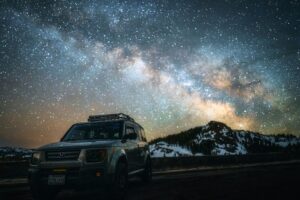At the dawn of time, before the glow of city lights, the night sky was our first television, our first calendar, and our most enduring source of wonder. It was a vast canvas of constellations, a map of the universe, and a reminder of our place within a grand cosmic design.
Today, in our brightly lit world, a truly dark sky is rare—and when you find one, it’s breathtaking. A night beneath unpolluted stars can fill you with both humility and awe.
Here at ReachTV, we believe travel is about more than places; it’s about transformative experiences. And few experiences compare to standing under a sky so clear you can trace the Milky Way with your bare eyes. For those seeking the ultimate celestial show, this is the definitive guide to the best places on Earth to stargaze, where the cosmos unveils itself in all its stunning glory.
The Science of Stargazing: What Makes a Sky So Special?
What separates a good stargazing spot from a truly epic one? Astronomers point to three essentials:
Minimal Light Pollution – The most important factor. City lights wash out fainter stars, planets, and galaxies. The best stargazing destinations are far from urban centers and carefully protected from artificial light.
Clear Skies – A cloudless, pollution-free atmosphere makes all the difference. Dry, arid climates and higher elevations usually provide the sharpest, most vibrant views.
High Altitude – Climbing above denser atmospheric layers reduces distortion, giving crisper, more dazzling clarity. It’s no accident that the world’s most advanced observatories sit atop mountains.
Many of the top destinations are recognized by DarkSky International as International Dark Sky Parks or Reserves—spaces committed to preserving the night sky for generations to come.
The World’s Top Stargazing Destinations
From South America’s deserts to New Zealand’s alpine valleys, here are three of the most extraordinary places to stargaze.
1. Atacama Desert, Chile: A Window to the Universe
If there’s a stargazing capital of the world, it’s the Atacama Desert. As the driest non-polar desert on Earth, with skies clear for most of the year and an average altitude of 2,400 meters (8,000 feet), it offers an unparalleled view of the cosmos.
Why It’s Special
The Atacama’s thin, dry air allows you to see stars, planets, and even the glowing arc of the Milky Way with astonishing clarity. In the Southern Hemisphere, you’ll glimpse celestial wonders unseen in the north—like the Southern Cross, Omega Centauri, and the Magellanic Clouds.
Where to Go
The desert town of San Pedro de Atacama has become the hub of “astro-tourism.” From here, you can book tours with telescopes and expert guides. For something truly out of this world, public tours at observatories like ALMA or Paranal allow you to witness cutting-edge astronomy firsthand (though these often require booking months in advance).
Best Time to Visit
The skies are spectacular year-round, but July and August bring especially crisp conditions. For the ultimate view, plan around a new moon to avoid light interference.
2. U.S. National Parks: Trailblazers in Dark Sky Preservation
The American Southwest is a stargazer’s dream. Here, vast landscapes and protected parks combine to create some of the darkest skies on the continent.
Why They’re Special
These parks hold official International Dark Sky Park designations, meaning light pollution is kept to a minimum. High desert altitudes, combined with dramatic backdrops like canyons and rock spires, make them ideal not only for stargazing but also for astrophotography.
Where to Go
Death Valley National Park, California – A “Gold Tier” Dark Sky Park, Death Valley is one of the darkest places in the contiguous U.S. Its sprawling desert and rugged terrain give you unobstructed views of the entire celestial dome.
Grand Canyon National Park, Arizona – Beyond its awe-inspiring daytime vistas, the Grand Canyon hosts nightly ranger-led stargazing programs and an annual Star Party, drawing astronomy enthusiasts from around the world.
Bryce Canyon National Park, Utah – Famous for its hoodoo rock formations, Bryce Canyon is one of the best places in the U.S. to see the Milky Way. On moonless nights, more than 7,500 stars become visible.
Best Time to Visit
Late spring and early fall provide the best balance of mild weather and clear skies. Winter nights, though colder, can be especially crisp and bright.

3. Aoraki Mackenzie Dark Sky Reserve, New Zealand
On the South Island of New Zealand lies the largest Dark Sky Reserve in the world—Aoraki Mackenzie. Here, the pristine alpine environment is as enchanting at night as it is during the day.
Why It’s Special
With strict light pollution controls and a “Gold Tier” status, Aoraki Mackenzie offers one of the purest night skies on Earth. It’s also one of the few places where you can catch glimpses of the Aurora Australis (Southern Lights).
Where to Go
Base yourself in Lake Tekapo, a charming lakeside town known for astro-tourism. The nearby Mt. John Observatory offers guided tours, or you can simply set up along the lake’s edge and watch stars shimmer across the water’s reflection.
Best Time to Visit
June through August is peak season for crystal-clear skies. Winter also increases your chances of seeing the Aurora Australis, adding an extra layer of magic to the experience.
Practical Tips for the Traveling Stargazer
Before you set off on your cosmic adventure, a few practical steps will make the experience even better:
Check the Moon Phase – New moons are best. A full moon, though beautiful, will drown out fainter stars.
Dress in Layers – Even warm deserts and valleys get cold after dark. Pack jackets, hats, gloves, and a thermos of something hot.
Use a Red Flashlight – Preserve your night vision by avoiding white light. Red light helps you see without disrupting your eyes’ adjustment.
Download Sky Apps – Apps like SkyView or Star Walk help you identify stars, constellations, and planets in real time.
Consider a Tour – Local guides bring the sky to life with stories, telescopes, and insider knowledge.
Conclusion: Gaze Up, Look Inward
Stargazing isn’t just about looking at the night sky—it’s about feeling connected to something larger. Under a truly dark sky, you glimpse the same stars that guided ancient travelers, inspired myths, and sparked scientific revolutions. It’s a reminder of how vast, mysterious, and beautiful the universe really is.
At ReachTV, we celebrate these moments of wonder. Whether you’re standing in the Atacama Desert, hiking through a U.S. national park, or gazing from New Zealand’s alpine lakes, the stars invite you to pause, reflect, and dream.
So pack your curiosity, chase the stars, and let the universe inspire your next great adventure.



